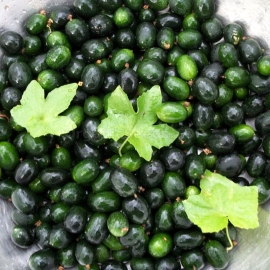 EXCLUSIVE
EXCLUSIVE






Organic Creeping Cucumber Seeds (Melothria Pendula)
3.90 €
A fast-growing vine with small, ivy-like leaves and curly tendrils, the creeping cucumber or drooping melonette produces very small fruits that look like jelly bean-size watermelons.
-
Organic Creeping Cucumber (Melothria Pendula)
A fast-growing vine with small, ivy-like leaves and curly tendrils, the creeping cucumber or drooping melonette produces very small fruits that look like jelly bean-size watermelons.
This perennial deciduous vine (although evergreen where frost never occurs) is native from the southern half of the United States to northern Argentina. The weedy vines will ramble across the soil like a groundcover, or quickly climb upward on a trellis, fence, shrub or tree.
The plants are frost-tender and need warm soil and temperatures to prosper. About 55 to 60 days after sowing seeds, the little immature green fruits are ready to harvest. Only eat the fruits when they are light to deep green, when you see mottled spots of silver white. They taste like tart cucumbers. Avoid eating fruits that have ripened to show any black skin. Consuming the mature seeds in these black-skinned fruits will cause diarrhea.
The creeping cucumber is a perennial vine to grow as an annual in the warmth and sunshine of summer. It has small, pointy lobed leaves (resembling ivy foliage) that are green with fuzzy undersides. Crush a leaf and the fragrance of cucumber is noticeable. When mature in summer's warmth, the vines produce tiny, five-lobed yellow flowers that are either male or female. Pollen-bearing male flowers are produced first, followed by the fruit-bearing female flowers. The female flowers are recognizable with close inspection because of the bulbous ovaries at their bases.
Grow these vines in full sun to bright partial shade and fertile, evenly moist, perfectly drained garden loam. After the threat of frost passes, sow the seeds directly in the ground. If transplanting container-grown plants, take care to not damage their tender white roots unless they are root-bound. Root-bound plants can be saved only if their roots are gently teased apart before planting. Be sure to harvest fruits regularly, so vines will continue to flower and produce fruit.
